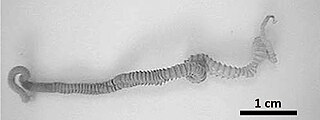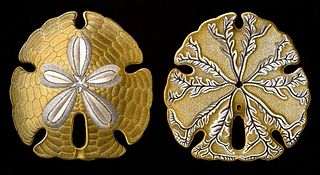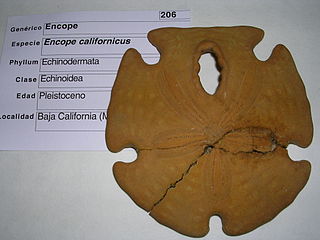
The Diadematidae are a family of sea urchins. Their tests are either rigid or flexible and their spines are long and hollow.

The brown four-eyed opossum is a pouchless marsupial of the family Didelphidae. It is found in different forested habitats of Central and South America, from Nicaragua to Brazil and northern Argentina, including southeastern Colombia, Paraguay and eastern Peru and Bolivia, at elevations from sea level to 1500 m. It is the only recognized species in the genus Metachirus, but molecular phylogenetics studies suggest that it should probably be split into several species. Population densities are usually low, and it is uncommon in parts of Central America. A density of 25.6/km2 was reported near Manaus, Brazil. Its karyotype has 2n = 14 and FN = 24.

Astropyga radiata, the red urchin, fire urchin, false fire urchin or blue-spotted urchin, is a species of sea urchin in the family Diadematidae. It is a large species with long spines and is found in the tropical Indo-Pacific region. It was first described in 1778 by the German naturalist Nathaniel Gottfried Leske.

Conulus is an extinct genus of echinoids that lived in the Cretaceous. Remains of Conulus species have been found in Asia, Europe, and North America.

Gigantorhynchus is a genus of Acanthocephala that parasitize marsupials, anteaters, and possibly baboons by attaching themselves to the intestines using their hook-covered proboscis. Their life cycle includes an egg stage found in host feces, a cystacanth (larval) stage in an intermediate host such as termites, and an adult stage where cystacanths mature in the intestines of the host. This genus is characterized by a cylindrical proboscis with a crown of robust hooks at the apex followed by numerous small hooks on the rest of the proboscis, a long body with pseudosegmentation, filiform lemnisci, and ellipsoid testes. The largest known specimen is the female G. ortizi with a length of around 240 millimetres (9.4 in) and a width of 2 millimetres (0.08 in). Genetic analysis on one species of Gigantorhynchus places it with the related genus Mediorhynchus in the family Gigantorhynchidae. Six species in this genus are distributed across Central and South America and possibly Zimbabwe. Infestation by a Gigantorhynchus species may cause partial obstructions of the intestines, severe lesions of the intestinal wall, and may lead to death.

Dorippe frascone, the urchin crab or carrier crab, is a small species of crab in the family Dorippidae that was first described scientifically by J.F.W. Herbst, in 1785. It is found in the Red Sea and parts of the western and eastern Indian Ocean. It often has a symbiotic relationship with a long-spined sea urchin and carries one around on its carapace.

Brissus latecarinatus is a species of sea urchins of the family Brissidae. Their armour is covered with spines. Brissus latecarinatus was first scientifically described in 1778 by Nathanael Gottfried Leske.

Brissus unicolor is a species of sea urchins of the family Brissidae. Their armour is covered with spines. Brissus unicolor was first scientifically described in 1778 by Nathanael Gottfried Leske.

Clypeasteridae is a family of sea urchins in the order Clypeasteroida. This family was first scientifically described in 1835 by the Swiss-American biologist Louis Agassiz.

Clypeaster humilis is a species of sea urchin in the Family Clypeasteridae. This species was first scientifically described in 1778 by the German biologist Nathanael Gottfried Leske. It occurs in the tropical Indo-Pacific region.

Parechinus angulosus, the Cape urchin, is a sea urchin in the family Parechinidae endemic to southern Africa.
Brissus is a genus of echinoderms belonging to the family Brissidae.
Astriclypeidae is a family of echinoderms belonging to the order Clypeasteroida.
Echinocyamus is a genus of echinoderms belonging to the family Fibulariidae.
Echinoneus is a genus of echinoderms belonging to the family Echinoneidae.

Encope emarginata is a species of echinoderm belonging to the family Mellitidae.

Encope is a genus of echinoderms belonging to the family Mellitidae.
Echinodiscus is the scientific name of several genera of organisms and may refer to:

Echinodiscus is a genus of sand dollars within the family Astriclypeidae. There are currently 14 species assigned to the genus, with a majority being extinct.














